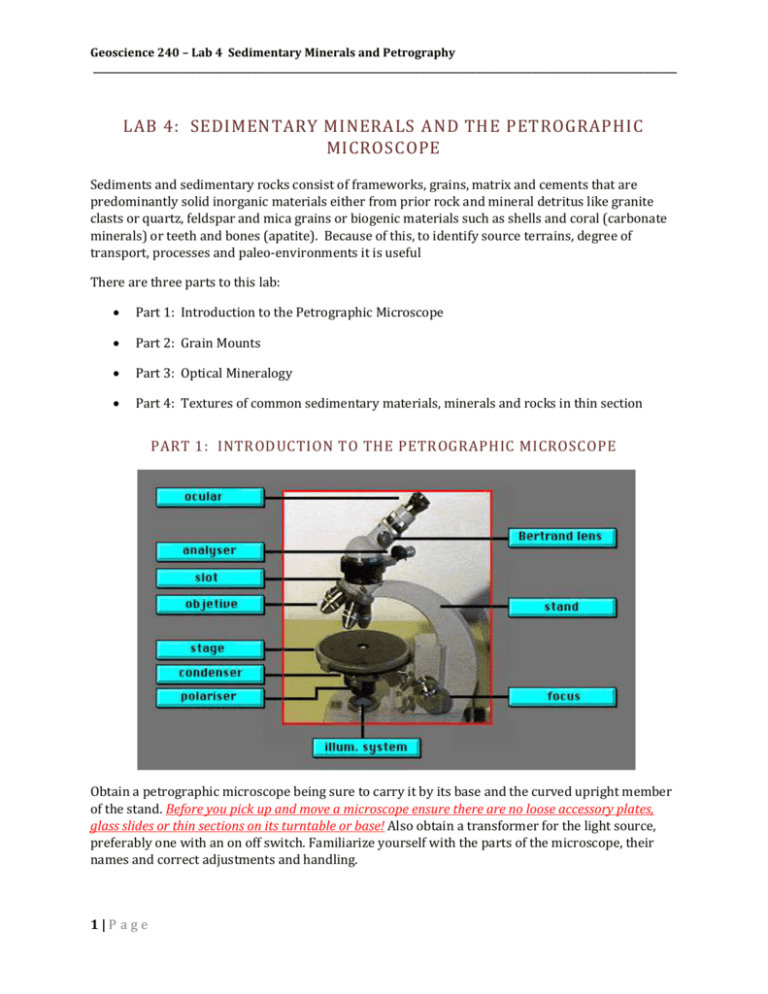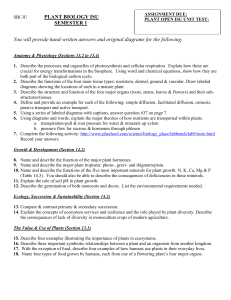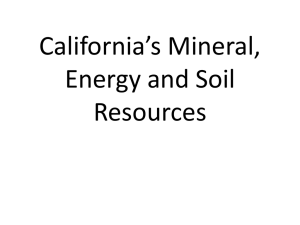GEOS240-Lab-04-Sedimentary-Minerals-and
advertisement

Geoscience 240 – Lab 4 Sedimentary Minerals and Petrography _____________________________________________________________________________________________________________________________ LAB 4: SEDIMENTARY MINERALS AND THE PETROGRAPHIC MICROSCOPE Sediments and sedimentary rocks consist of frameworks, grains, matrix and cements that are predominantly solid inorganic materials either from prior rock and mineral detritus like granite clasts or quartz, feldspar and mica grains or biogenic materials such as shells and coral (carbonate minerals) or teeth and bones (apatite). Because of this, to identify source terrains, degree of transport, processes and paleo-environments it is useful There are three parts to this lab: Part 1: Introduction to the Petrographic Microscope Part 2: Grain Mounts Part 3: Optical Mineralogy Part 4: Textures of common sedimentary materials, minerals and rocks in thin section PART 1: INTRODUCTION TO THE PETROGRAPHIC MICROSCOPE Obtain a petrographic microscope being sure to carry it by its base and the curved upright member of the stand. Before you pick up and move a microscope ensure there are no loose accessory plates, glass slides or thin sections on its turntable or base! Also obtain a transformer for the light source, preferably one with an on off switch. Familiarize yourself with the parts of the microscope, their names and correct adjustments and handling. 1|Page Geoscience 240 – Lab 4 Sedimentary Minerals and Petrography _____________________________________________________________________________________________________________________________ Ocular-eyepiece – usually 10X or 12X with cross hairs and a barrel focus controlled by the knurled ring. Bring the cross hairs into focus first, then raise or lower the stage to focus on the slide. Do not touch the flat surface of the eyepiece lens with your greasy fingers or eyeballs! The former will smudge the image and the latter will hurt or damage your cornea! Bertrand Lens – A knob below the eyepiece that is used for taking optical interference figures using a small conoscopic lens or pinhole. The normal position has an open bore with this optic rotated out of the optic train. This is used only within single grains, when the objective is fully cenetered, under hiogh power magnification. Other than for optic sign determinations (+ or -), it is not used. Analyser or Upper Nicols Prism – This is a lever or a sliding insert at the base of the upper portion of the scope usually where the scope angles for convenient viewing. This alternately inserts or removes a thin slice of mineral or other polarizing material which constrains the emitted light only to vibrate E-W (across the scope). This permits either Plane polarized PPL or cross polarized XPL viewing of mineral specimens to identify their basic internal structure (Isotropic or anisotropic) by how they interact with the polarized transmitted light from below. Viewing in PPL permits easy recognition of grain boundaries, relief, texture, cleavages, fractures, inherent colouration, zonation, pleochroism alteration, and inclusions. Viewing in PPL permits the recognition of isotropic phases, pore space, birefringent minerals, Z angle c (cleavage to optic axis or optic angle). Accessory Plate Slot – Permits the insertion of a ¼ wavelength mica or gypsum plate, a rot-1 plate or a quartz wedge for adding or subtracting known amounts of retardation to measure birefringence and optic sign in minerals with known orientation. The accessory plates cost $200-500 apiece so please do not drop them! Stand – this is your handle for carrying the microscope and it provides alignment and rigidity for the optic train. It is not a Klingon Bat’leth! Objectives and Turret – The objectives, generally in 2.5X (brown), 10X (yellow) and 40X (blue) magnification allow different field of view versus degree of detail. E.g. overall texture of grains versus cements or structures within a single grain or microfossil. On our scopes these give field of view (FOV) of 7 mm, 1.4 mm and 0.4 mm respectively for the diameter of the circular area illuminated. This permits you to estimate grain sizes and to name sediments by their particle size distributions, sandstone versus siltstone versus wacke etc. Too change objectives ensure the stage is suitably dropped before rotating the turret and do not go from medium to high power until the stage is backed off a bit to avoid breaking a thin section $25 each or damaging the delicate objective lens. Only rotate the turret by the large knurled ring! Do not grab the individual objective lenses by their cylindrical barrels to change powers! Near the head of each objective are 2 small delicate knurled rings which permit centering of the objective. This is a delicate, difficult and time consuming procedure for a technician. Please do not grab by these rings and throw things out of aim or you will not be able to rotate the stage and stay on the grain of interest! Stage and clips – This platform is bored with holes to hold stage clips which can fasten down slides to ensure area of interest is not lost. Stage clips will also stop slides from flinging across the lab if you are too zealous in rotating the stage! The stage can be rotated to measure angles between grain elongation, cleavages and optic directions to help identify minerals. It has a 360° ruled scale on its circumference along with a locking screw and vernier toi measure angles to less than a degree. When the stage is roated under PPL some iron bearing minerals change colour, displaying pleochroism. This can help to identify and distinguish various common ferromagnesian minerals 2|Page Geoscience 240 – Lab 4 Sedimentary Minerals and Petrography _____________________________________________________________________________________________________________________________ such as: Biotite (brown-red-tan), Hornblende (Brown-green-tan), Titaniferous Augite (Pale pinkBrown) and other pyroxenes and amphiboles. Condenser lens or illuminator and polarizer – There is a rack and pinion mounted small cylinder on your scopes with a frosted grey sub-stage polarizer and a light source that can be raised and lowered to change intensity of light. For relief and general texture observations under PPL, keep it lowered somewhat and a bit on the dim side. Some allow bulbs to be centered only with a tool and 3 offset screws, others have a small joystick allowing for finger alignment to aim the light up the center of the optic train. For dark specimens that are not very transparent, to illuminate a single grain or for taking optical interference figures under high power objective, raise this up close to the stage. On more expensive microscopes the light source is below inside the base and this is a flip in/ flip our substage condenser lens that provides focused conoscopic illumination for the above mentioned purposes. The polarizer passes PPL Plane polarized light that is constrained to vibrate N-S (in the vertical plane of the microscope’s symmetry). This provides light of know orientation for measurement of angles and vector optical properties within anisotropic mineral lattices. Focus – This is a double barreled knob on the sides of the scope which permits the stage to be raised and lowered to bring specimens within focus. The larg ring travels quickly while the smaller inset knob is for delicate final adjustment. It is good practice to start on low power with the objective turret (brown lens) in position and look from the side while you raise the stage up as far as it goes before dropping it to find the focus. Ensure the thin sections are right side up and that grain mounds are made on single glass slides with a thin cover slip. Do not use slides upside down or use another glass slide for a cover slip as the higher power objective cannot get close enough to focus without bumping and scratching the objective or breaking the slide. To join my bozo club and have to sit out the lab in the corner with abucket on your head ignore the previous instructions! Illumination System – Transformer – Our scopes have a delicate little female 2 pin socket plug which insets gently at eh side of the sub stage light source and polarizer barrel. The other end is a grounded plug. Some have on-off switches. Keep them turned off or unplugged when not in use as the tiny light bulbs are expensive, burn out and are a pain in the patoot to replace and refocus. Some allow 2 levels of illumination depending on the pug direction into the illuminator housing. 1-a. Acquaint yourself with the components above and discuss their various functions and adjustments with a lab partner or instructor. For most purposes you do not need to use the high power objectives. In transmitted light most materials, glass, air, water, oil, epoxy, minerals etc are transparent when if they are cloudy, bubbly with inclusions or inherently coloured. By contrast denser things made of metals (gold, copper, platinum), metal oxides (magnetite, hematite, ilmentite, pyrolusite, cuprite), metal sulfides (pyrite, galena, chalcopyrite, argentite, arsenopyrite), graphite or graphite like carbonized organic matter are opaque and appear black or another solid colour (brown, red, golden etc.) when viewed from above. The ones you cannot see through in PPL are termed opaque. For the transparent ones, there are 2 basic optical types: isotropic meaning cubic or a single refractive index in all directions regardless of orientation and anisotropic which means they have 2 or 3 different principal refractive indices that are a function of a grains internal structure and orientation. For isotropic or cubic substances: glasses, halite, garnet, tar etc. when you cross the analyser (upper polarizer) clear things go black and remain black on 360° rotation. For anisotropic things: most minerals including quartz, feldspars, calcite, epidote, micas, amphiboles, pyroxenes, corundum, apatite etc. they might appear transparent in PPL but crossing the upper polarizer gives 3|Page Geoscience 240 – Lab 4 Sedimentary Minerals and Petrography _____________________________________________________________________________________________________________________________ them false birefringence colours that vary between whites or greys at the low end to hot rainbow (psychedelic!) colours alternating with 4 black extinction positions as you rotate the stage through 360°. This is because the passage of light is a vector refraction property of the crustal lattice and there are only 4 special positions when the optic directions in the crystal are rotated into coincidence with the polarizer or analyser direction of the scope that permits light to pass through unrotated and to be blocked out by the upper analyser. All crystal systems other than cubic are anisotropic : tetragonal (zircon, thorite, anatase, rutile, scapolite, scheelite) and hexagonal (quartz, calcite, dolomite, corundum, apatite) minerals have 2 principle refractive indices and are termed uniaxial. Most minerals are more complex and less symmetric in their structures and have 3 principle refractive indices and are termed biaxial including: orthorhombic (olivine, hypersthene, grunerite, zoisite, aragonite), monoclinic (micas, hornblende, augite) or triclinic (feldspars, turquoise, kyanite, wollastonite, brittle micas). Obtain a thin section of a porphyritic volcanic or a plutonic igneous rock and find and describe each of the items below and explain briefly how you know it has this type of optical behavior: 1-b. (2) Rock specimen name and thin section number: _____________________________________________ 1-c. (2) Opaque minerals/materials - can you identify them by their reflectance using another light source or shape? – 1-d.(2) Isotropic materials – How can you tell these materials are isotropic and what does this mean concerning their internal structure? 1-e. (2) Anisotropic materials - How can you tell these materials are anisotropic by observations in PPL and what does this mean concerning their internal structure? PART 2: GRAIN MOUNTS Obtain clean unused long format glass slides, cover slips and Group A: sieved silt sized (<60 microns) volcanic ash, quartz or garnet and Group B: mineral materials having a cleavage: Calcite, Gypsum, Muscovite, Biotite, K-Feldspar, Plagioclase. Gently take a few grains (10-15) of material from one of each of the 2 groups, put a drop of water on them with a disposable pipette and gently place a cover slip along one edge of the drop, lowering it across the grains. If you have too much or too little water adjuct with the dropper or kimwipes accordingly. Examine each grain mount under PPL and XPL. Draw, label, include a scale bar and describe one specimen from each group, then examine each other’s slides. Relief is a relative term to describe how different the refractive index (indices) are from each other (when viewed in PPL) from the glass slide itself or mounting medium, water, oil, epoxy etc. Relief depends on grain 4|Page Geoscience 240 – Lab 4 Sedimentary Minerals and Petrography _____________________________________________________________________________________________________________________________ thickness as well as refractive indes and even position of the crystal if there is more than one RI. The volcanic glass, quartz, feldspar and mica will have relatively low relief while the garnet and biotite will appear bolder as if they really have cliff like edges and they also go in and out of focus with very little fine focus adjustment. Note if any of these materials have inclusions, cleavage, fracture, twinning or inclination of the extinction direction with respect to grain edges or cleavage directions. 2-a. Group A – Sample name ______________________________ Sketch and description (5): 2-b. Group B – Sample name ______________________________ Sketch and description (5): PART 3: OPTICAL MINERALOGY AND CRYSTALLOGRAPHY Minerals crystallize in one of 6 general classes of internal structures that are distinguished by their internal symmetry and external crystal morphology. Depending on how they pass versus reflect or block incident light, minerals are either Transparent (in thin enough slices) like most silicate, carbonate and phosphate minerals or Opaque, like most native metals (Au, Cu, Ag, Pt, Sb), transition metal oxides (Magnetite, Chromite, Pyrolusite, Cuprite), sulfides (Galena, Chalcopyrite, Pyrite, Argentite) or arsenides (Arsenopyrite). Isotropic – Goes extinct on 360° rotation in cross polarized light (with analyser clicked in). Looks transparent in PPL but Black in XPL. All minerals that do this are Cubic-Isometric. These materials have one refractive index (slowness of light) and a spherical indicatrix. 5|Page Geoscience 240 – Lab 4 Sedimentary Minerals and Petrography _____________________________________________________________________________________________________________________________ Cubic = Isometric – These substances or minerals have only 1 refractive index. Includes highly ordered, regular crystl structures that are equal in all dimensions such as: Halite, Sylvite, Fluorite, Analcite, Garnet, Diamond, Spinel, Cubic Zirconia as well as disordered or microcrystalline structures with random orientations including: air, water, oil, pyrobitumen, volcanic glass, opal, poorly crystalline clays and metamict minerals damaged by radiation haloes around pitchblende, zircon, monazite and other minerals with significant U or Th content more than a few %. Common external crystal forms include: cubes, octahedral, tetrahedral, dodecahedra, pyritohedra, gyroids etc. Some cubic minerals are 3-D tough and only have irregular or conchoidal fracture, while others have longer or weaker bonds in 3, 4 or 6 different directions and have regular cleavages and cleavage fragments: 3-cubes (Halite, Sylvite) , 4-tetrahedral or octahedral (Fluorite, Diamond), or 6-dodecahedra (Sphalerite). Anisotropic - All other crystalline substances, minerals are not isotropic and have 2 or 3 different refractive indices in 3 perpendicular directions. These minerals exhibit unusual or extraordinary refractive qualities in cross polarixed light which allows gemologists to determine what they are by simple visual examination in doubly polarized light (or falsify them if you just bought coloured glass!). Under cross polarized light XPL, these substances have 4 perpendicular extinction positions and in between these, they exhibit false interference colours or birefringence. The external manifestation of this and jewelers term is dichroism (2 colours or change of colours upon rotation). Uniaxial minerals - Substances with 2 refractive indices have a Uniaxial Indicatrix that resembles a prolate or oblate ellipsoid of revolution. Prolate ones have a smaller ordinary RI and are termed optically positive and usually length fast. Oblate ones have a larger ordinary RI and are termed optically negative and are usually length slow. All Uniaxial minerals belong to either Hexagonal (Quartz, Calcite and other Rhombohedral Carbonates, Corundum, Apatite, Nepheline and Ice-I) or Tetragonal (Anatase, Cassiterite, Chalcopyrite, Scheelite, Scapolite, Thorite, Vesuvianite, Zircon). Of these more symmetric minerals having either a 4-fold or a 6-fold rotational axis of symmetry, Those with only faint 1st grey to pale white birefringence include: Corundum, Apatite, Nepheline and Vesuvianite. By contrast, Zircon has high birefringence with hot colours even for the smallest grains and calcite has extreme 6th or 7th order birefringence that twinkles, looks salmon pink in XPL and is called “high white” as the rainbow colours are so close together they almost merge back into white light. The other onesmentioned above have maximum birefringence colours around 1st white to pale yellow but can look grey or nearly black when viewed down the 4 or 6 fold-symmetry direction and single optic axis. Watch how quartz varies when you lay the prism down versus look down the pyramid, or calcite laid on a rhomb cleavage versus looking down the 3 fold corner. Biaxial Minerals – Substances with 3 different principal refractive indices (perpendicular to each other are termed biaxial. Their indicatrix has 3 different elliptical cross sections and 2 circular sections when viewing down either of the 2 optic axes. Minerals in the Orthorhombic, Monoclinic and Triclinic Crystal classes are all biaxial. By number, Orthorhombic and Monoclinic minerals are the most abundant. A few are of interest in sedimentary petrography. Orthorhombic minerals include: Olivine, Topaz, Aragonite (orthocarbonate group), Barite (ortho-sulphate group), Enstatite-Hypersthene (orthopyroxene group), Grunerite (orthoamphibole group) and Zoisite. Monoclinic minerals include: Augite, Biotite, Celsian, Chlorite, Epidote, Feldspar (low), Gypsum, Jadeite, Muscovite, Talc and 6|Page Geoscience 240 – Lab 4 Sedimentary Minerals and Petrography _____________________________________________________________________________________________________________________________ Tremolite. Triclinic minerals include: Albite through Anorthite Plagioclase Feldspars, Chloritoid (Brittle micas), Kyanite, Microcline K-Feldspar, Pectolite, Rhodonite, Turqoise, Wollastonite. Aragonite is the carbonate of sea shells with needles perpendicular to the shell surfaces for added strength. Fe-rich olivine survives in desert environments. Epidote has high birefringence colours. Augite has high birefringence and prismatic nearly right angle cleavage. Biotite, hornblende and chlorite are frequently pleochroic (changing colours of green brown tan in PPL. Hornblende has 56/124° cleavage and is splintery. Feldspars have nearly right angle cleavage, low greys and whites for birefringence and diverse twin laws plus concentric zonation in volcanics. Plagioclase can alter to calcite and clays. Alkali feldspars frequently alter to clays and have perthite exsolution. Epidote, chloritoid, jadeite, olivine, augite and hornblende can all be green in PPL. Instructions: Use the large bench top light sources from physics with polarizing films and a few thin transparent mineral specimens of: halite, fluorite, prismatic quartz, clear or optical calcite rhombs, gypsum rhombs (var, selenite) and muscovite sheets or thin books. Note whether each mineral is isotropic or anisotropic and draw crystals and describe or label the relationship between their crystal growth or cleavage shapes and special optical directions according to polarizing directions. Note that unlike your petrographic microscopes, these light stands and filters are polarized in the 45 degree positions NW-SE and NE-SW. 3-a Halite (3) 3-b Fluorite (3) 3-c Calcite (3) 7|Page Geoscience 240 – Lab 4 Sedimentary Minerals and Petrography _____________________________________________________________________________________________________________________________ 3-d Quartz (3) 3-e Gypsum (3) 3-e Muscovite (3) PART 4: PETROGRAPHIC DESCRIPTION OF SANDSTONES PROCEDURE Obtain in turn, a thin section of each type of the following coarse grained sandstones: Quartz sandstone (Potsdam or Navajo) #_______________, arkose #_____________, greywacke #_______________, glauconitic #______________. Draw, label scales, label grain types, matrix (if present), cement(s) and any special structures or textures visible in thin section: lamination, cross beds, fractures, fossils, oil staining etc., then fill out a petrographic data sheet from the lab manual p 42 including all observations requested. For colours refer to a paired hand specimen. The Quartzite is mature and either a long system or multi cycle sandstone. The arkose is a 1st cycle or short system continental sediment derived from a convergent margin mountain belt or an eroded shield area. The Greywacke should contain rock fragments of volcanic or sedimentary material and represents 1st cycle and short system deposition of either an arc or passive margin. The glauconite is a sub-tropical to higher latitude marine shelf lag deposit typical of a sediment starved or reworked storm shelf where upwelling and biological debris are significant components. 8|Page Geoscience 240 – Lab 4 Sedimentary Minerals and Petrography _____________________________________________________________________________________________________________________________ 4-a. Quartzite #_________________________ (5) 4-b Arkose #_____________________________(5) 4-c. Greywacke #________________________(5) 4-d Glauconitic Sandstone #_____________ (5) 4-e Magnetite rich placer sandstone, Jurassic, Crowsnest Pass# ____________ (5) 4-f Magnetite rich “Black Sand” from Sidney Spit# _______________ (5) 4-g Placer gold concentrate in vial for exam under binocular scope. # ________________ (5) 9|Page Geoscience 240 – Lab 4 Sedimentary Minerals and Petrography _____________________________________________________________________________________________________________________________ 10 | P a g e Geoscience 240 – Lab 4 Sedimentary Minerals and Petrography _____________________________________________________________________________________________________________________________ 11 | P a g e









